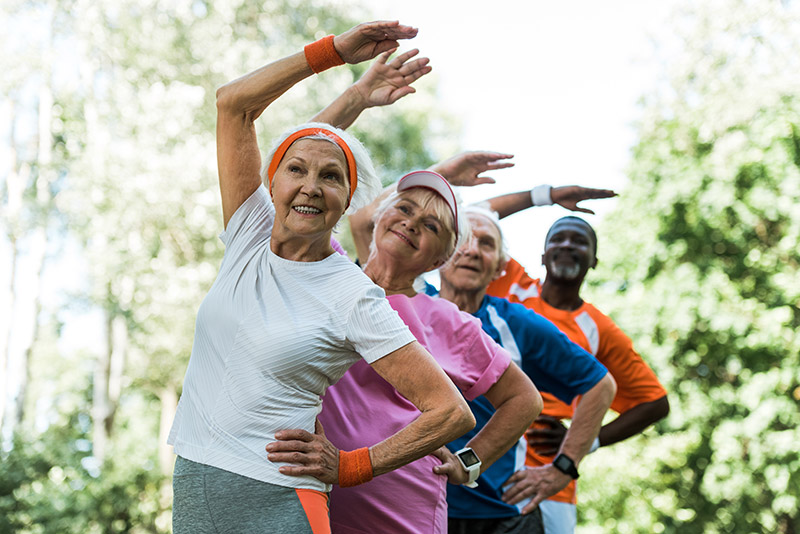Fit at Any Age: A Senior’s Guide to Safe and Effective Exercise
The U.S. Centers for Disease Control (CDC) recommends that adults aged 65 and older get at least two and half hours of moderate exercise each week, which comes out to around 30 minutes, five days a week.
There’s no denying that exercise is beneficial for both physical and mental health, and it can even alleviate or resolve some chronic health problems. But as we get older, our bodies get less resilient. That intense workout routine that worked great in our 40s just isn’t possible when we reach our 60s.
But there are plenty of ways for seniors to exercise safely and effectively, even with limited mobility. Just make sure you talk to your doctor and get the all clear before beginning any new workouts or training programs, especially if you’re new to exercising.
When you’re ready to begin, here are some great exercise options for seniors of all physical ability levels.
Why exercise is important for seniors
While regularly moving your body is key to a good quality of life for people of any age, it’s especially important for older adults who may not get out and about as often. Regular moderate aerobic exercise can help older adults improve and maintain their:
- Muscle strength and mass: Keeping muscles strong helps with everyday activities and maintains mobility.
- Balance and coordination: Improved balance reduces the risk of falls, a major concern for older adults.
- Cognitive function: Regular physical activity can help keep your mind sharp.
- Emotional health: Exercise is a great mood booster, helping to ward off depression and anxiety.
- Independence: Staying active and keeping your body in good shape will help you live independently for longer.
By making exercise a habit, seniors can live longer, healthier, happier lives. But it’s important to exercise safely and avoid pushing your body past its limits, especially if you have chronic health problems or physical limitations.
Exercises for seniors with full mobility
If you have low or no physical limitations, there are all kinds of different exercises you can do. But the easiest way to stick with a workout routine is to find an activity that you genuinely enjoy and look forward to. So try out some different activities until you find one you love—after all, it’s never too late to learn something new!
Many seniors, even if they’re in good health, need low-impact exercises that put less stress on their joints. These workout options will improve joint function, rather than hurting it.
- Yoga: Yoga is a good way to improve your strength, balance, and flexibility. You can use beginner-level DVDs or online videos to start practicing at home, or you can attend classes at a local gym or yoga studio.
- Pilates: Pilates offers many of the same benefits as yoga, but with a greater emphasis on building strength and muscle mass. While you can do some Pilates training at home, some of the exercises require specialized equipment that you’ll find in a gym or Pilates studio.
- Swimming: Swimming is a fantastic low-impact exercise that works every part of the body. If you don’t have access to a private pool, many gyms and recreation centers have lap pools for exercise.
- Water aerobics: Water aerobics classes are extremely popular, as this type of workout is ideal for individuals with weak or painful joints. The buoyancy of the water eases joint stress, while the natural resistance helps build strength.
- Walking: Simple and classic, walking is a fun, relaxing way to get into an exercise routine. You can stroll through your neighborhood, walk around your local mall, or take a nature walk through the woods for some added benefits.
- Resistance band training: An affordable basic set of resistance bands can provide you with a full workout that addresses every part of your body. You can easily do resistance band training at home and create your own routine or follow along with a video.
- Pickleball: This paddle sport has taken the world by storm, and it’s especially popular among seniors for its social aspect and moderate physical demand. It’s played on a badminton-sized court with a lowered net, making it more accessible than tennis.
Exercises for seniors with limited mobility
If mobility is an issue, there are still plenty of ways to stay active. These exercise routines are great for seniors who have difficulty standing or walking—just make sure you get approval from your doctor before you start.
- Chair yoga: Like regular yoga, chair yoga helps improve strength and flexibility. But you can do it completely from a seated position, so it’s ideal for people with mobility or balance issues.
- Range of motion: This type of exercise consists mainly of gentle stretching to improve joint function and range of motion and reduce stiffness. But you’ll need the help of a friend, caregiver, or physical therapist who can gently and safely ease you into the stretches.
- Pedal exercises: With this workout, you use a small machine called a pedal exerciser to improve arm and leg strength. It’s simple to do, only requires one compact piece of equipment, and is designed to be performed from a bed or chair.
- Resistance band training: Resistance band training made it on both lists because it’s fully adaptable to fit any ability level. If you have difficulty standing or walking, you can use resistance bands from a seated or even reclined position.
Keep safety in mind while exercising
While exercise is great for your physical and mental well-being, don’t forget to work out safely by following these tips:
- Consult your doctor: Always check with your healthcare provider before starting a new exercise program, especially if you have existing health issues.
- Listen to your body: Mild soreness is normal, but sharp or lingering pain is a sign to stop and get checked out by your doctor.
- Stay hydrated: Your muscles are made up of 79% water—so drink plenty of it before, during, and after your workout, even if you don’t feel thirsty.
- Wear proper gear: Good athletic shoes can improve stability and support, reducing the risk of falls.
- Get a workout partner: A workout buddy keeps you accountable and provides a second set of eyes to make sure you’re using the right form and performing exercises safely.
Stay fit and active with the help of Right Hand Care
No matter your age or ability level, getting your body moving leads to better physical health, mental well-being, and overall quality of life. But staying active doesn’t have to be a solo experience. If you need professional support or just someone to keep you accountable, Right Hand Senior Care is here to help.
We’re dedicated to helping seniors enjoy the healthiest, happiest, most independent lives possible. In addition to regular caregiving services, our friendly, experienced in-home caregivers can assist with daily workouts, keep you motivated, and make sure you’re staying safe.
Get in touch with us today, and we’ll match you with the perfect in-home caregiver for your needs.

We are Superheroes in Comfortable Clothes™
We take care of our clients, their families, our staff, and our league of franchise owners.

